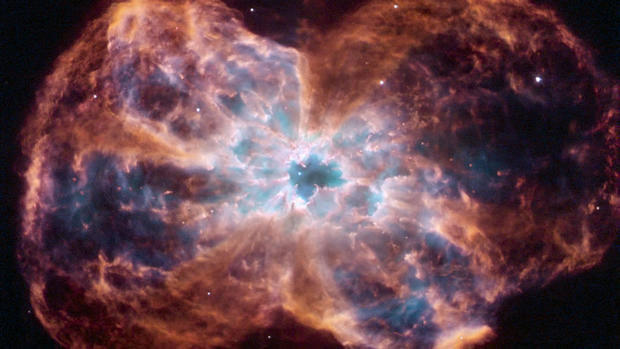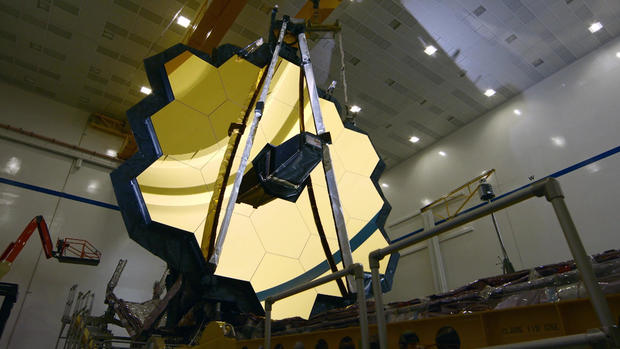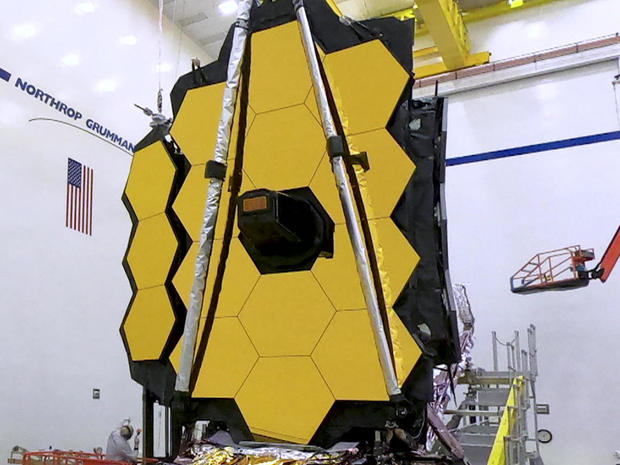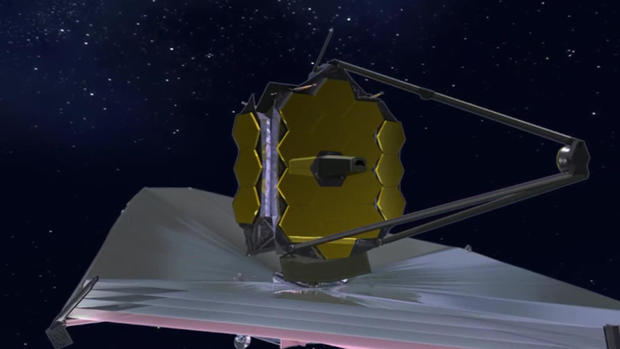In 1990, NASA launched the Hubble Space Telescope. It had faced years of delays and cost overruns, but it proved the existence of black holes, calculated the age of the universe, and delivered astonishing views of deep space.
But now, NASA has built something 100 times more powerful, capable of seeing stars so distant, their light has been traveling for nearly 14 billion years, since just after the Big Bang. It's the most ambitious, complex space observatory ever built: the James Webb Space Telescope. And it's scheduled to lift off in 10 days.
Scott Willoughby works for Northrup Grumman (which NASA hired to do most of the design and construction), and is the Webb's program manager. "It's got seven times the collecting area, a mirror which collects more light, to see things that are either dimmer or further away," Willoughby explained.
The Webb will see a different kind of light than the Hubble did – the light from very distant, very old stars is infrared light.
"So, we're designing an eye like night vision goggles for the sky, where we're going to find infrared out in the universe," said Willoughby.
The main mirror is made up of 18 gold hexagons, each adjustable. Correspondent David Pogue asked, "Was it made golden for looks?"
"It was not!" Willoughby replied. "Gold reflects infrared."
Now, infrared is a form of heat. So, any warmth from the sun and the Earth would blind this telescope to distant starlight. The telescope can only work if it is super-cold – like space itself. To block out any shred of sunlight, the Webb will deploy a sun shield. It has five layers of a material like Mylar, each one the thickness of a human hair, that will separate the cold side (-400°F) from the hot side (about +200°F), and keep sunlight from ever touching the mirrors' surface.
There's another way to keep a telescope cold, too: "We send it four times further away than the moon; we're one million miles away," Willoughby said. "And with that, we can keep our optics colder."
But you haven't even heard the hardest part. This telescope is three stories tall and as wide as a tennis court – too big to fit into any existing rocket. NASA's solution? Fold it up, like origami.
Pogue said, "This is the part that worries me as a layperson. I mean, how complex is this unfolding process?"
"It's good to be worried!" said Willoughby. "They have things that are called single-point failures, right? This has to move this way, and there's only one of 'em, right? And Webb has over 300 of those."
"Three hundred things that have to go exactly right?"
"Correct."
If even one of them fails, the Webb telescope becomes the Web space junk. A million miles is much too far away to send a repair mission, as we did for the Hubble.
"So, what do you do with those?" Willoughby said. "You test 'em to greater extremes than they'll ever see."
All that additional testing and caution helps explain the telescope's 14 years of delays, and its $9.7 billion price tag.
"Every time we learn something, we had to repeat a series of tests," said Willoughby. "But all of that is because we have to learn on the ground."
Pogue asked, "So, at this point, days away from the launch, how confident are you?"
"Confidence is built, to me, out of, 'Did we do everything that we could possibly have done?' I can confidently say we did everything that we needed to do. We took every piece of it and we did the best we absolutely, possibly could."
If all goes well, then by the summer of 2022, this machine will get down to its work: Science.
NASA's Stefanie Milam, one of the telescope's science officers, said, "JWST is going to rewrite the textbooks. And I think the science that's going to come out of this is mind-blowing.
"We're going to see the first stars and galaxies and understand how the evolution of our universe actually started. We're going to be able to study the atmospheres of planets around other stars that we've never had access to."
Most exciting of all, Milam expects the Webb Telescope to discover things we never even thought to look for, as the Hubble has done many times. "There are going to be things that we aren't prepared for," she said. "We'll have to figure out how to use the telescope in different ways and plan for the unexpected."
After the scheduled launch on December 22, Scott Willoughby will have to wait 29 days to find out if the unfolding worked, and then five months more for the telescope to calibrate and cool down. "So, in the end, it takes us a half-a-year before you'll be reporting on some image that humankind has never seen before in our lives," he said.
"And is that the point where you can finally sleep at night?" Pogue asked.
"Yeah. I'll feel a lot better then!"
For more info:
Story produced by Young Kim. Editor: Emanuele Secci.
Download our Free App
For Breaking News & Analysis Download the Free CBS News app
"looking" - Google News
December 12, 2021 at 09:53PM
https://ift.tt/31Tt8mm
The James Webb Space Telescope: Looking back towards the beginning of time - CBS News
"looking" - Google News
https://ift.tt/2tdCiJt
Shoes Man Tutorial
Pos News Update
Meme Update
Korean Entertainment News
Japan News Update
Bagikan Berita Ini


















0 Response to "The James Webb Space Telescope: Looking back towards the beginning of time - CBS News"
Post a Comment